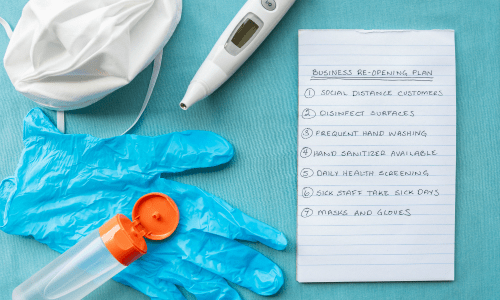
5.29.20 – SSI – Rodney Bosch
The guidelines are intended to remake office spaces and run from technical advice on HVAC systems, erecting physical barriers, promoting hygiene and more.
WASHINGTON, D.C. — The Centers for Disease Control and Prevention (CDC) has issued a step-by-step guideline for employers on how to reopen amid the ongoing coronavirus pandemic.
The new guidance, released May 27, provides a detailed checklist for employers to ensure office spaces are physically equipped and arranged for workers to return and prevent the spread of COVID-19, the disease caused by the novel coronavirus.
The sweeping recommendations run from technical advice on HVAC systems, how to maintain social distancing through physical barriers or staggered shifts, to eliminating traditional office extras like coffee machines and snack bins.
Prior to resuming business operations, employers are encouraged to take steps to see if facilities and office spaces are ready for occupancy. This includes:
- Increase circulation of outdoor air as much as possible by opening windows and doors, using fans and other methods.
- Evaluate the building and its mechanical and life-safety systems to determine if the building is ready for occupancy. Check for hazards associated with prolonged facility shutdown such as mold growth, rodents or pest or issues with stagnant water systems, and take appropriate remedial actions.
The health agency suggests employers should consider conducting daily in-person or virtual health checks, including temperature screening, to identify symptomatic individuals. Guidance for cleaning and disinfecting is detailed, as well as personal hygiene expectations.
For workers who commute to work using public transportation or ride sharing, employers are encouraged to consider offering the following support:
- Offer employees incentives to use forms of transportation that minimize close contact with others, such as offering reimbursement for parking for commuting to work alone or single-occupancy rides.
- Allow employees to shift their hours so they can commute during less busy times.
- Ask employees to wash their hands as soon as possible after their trip.
The CDC recommends “engineering controls” over administrative and personal protective equipment (PPE) for mitigating potential exposures in the workplace, “because they are designed to remove the hazard at the source, before it comes in contact with the worker,” the agency states.
The guideline says to modify or adjust seats, furniture and workstations to maintain social distancing of six feet between employees. Suggestions include:
- Install transparent shields or other physical barriers where possible to separate employees and visitors where social distancing is not an option.
- Arrange reception or other communal seating area chairs by turning, draping (covering chair with tape or fabric so seats cannot be used), spacing, or removing chairs to maintain social distancing.
“The initial cost of engineering controls can be higher than the cost of administrative controls or PPE, but over the longer term, operating costs are frequently lower, and in some instances, can provide a cost savings in other areas of the process,” according to the CDC.
Supervisors and employees should be informed about steps they can take to protect themselves at work. To help in this area, the CDC offers simple posters available free to download and print, some of which are translated into different languages.
To read the complete guidelines, go here.
